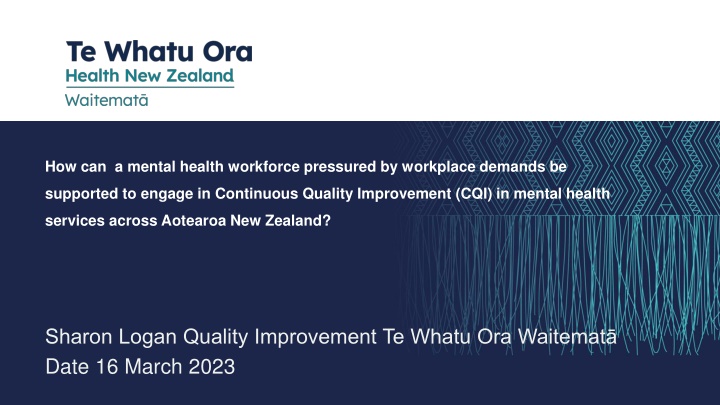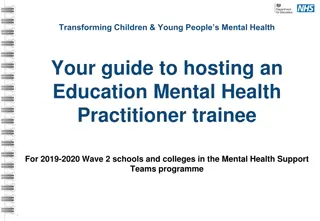Supporting Mental Health Workforce Engagement in Continuous Quality Improvement
Staff engagement in Continuous Quality Improvement (CQI) is crucial for enhancing mental health services. Key enablers include clear aims, sustained commitment, adequate resources, leadership training, and empowering communication. Structural considerations involve centralizing CQI efforts, providing training, coaching, and fostering a cultural leadership style. Effective strategies include co-design, small sustained changes, flexibility, and impactful measurement practices. Staff empowerment, engagement, and capability are essential for successful CQI implementation in mental health services.
Download Presentation

Please find below an Image/Link to download the presentation.
The content on the website is provided AS IS for your information and personal use only. It may not be sold, licensed, or shared on other websites without obtaining consent from the author.If you encounter any issues during the download, it is possible that the publisher has removed the file from their server.
You are allowed to download the files provided on this website for personal or commercial use, subject to the condition that they are used lawfully. All files are the property of their respective owners.
The content on the website is provided AS IS for your information and personal use only. It may not be sold, licensed, or shared on other websites without obtaining consent from the author.
E N D
Presentation Transcript
How can a mental health workforce pressured by workplace demands be supported to engage in Continuous Quality Improvement (CQI) in mental health services across Aotearoa New Zealand? Sharon Logan Quality Improvement Te Whatu Ora Waitemat Date 16 March 2023
Staff engagement Staff engagement in CQI refers to the direct involvement and participation of staff in QI; where staff take responsibility for QI activities, design, implementation and evaluation of outcomes. Engaged workforce and staff engagement in CQI is a critical component of healthcare safety, organisational effectiveness and is a key strategic priority favoured approach is transformative QI culture
Key enablers Strategic Priority - staff engagement in CQI clear aims and sustained commitment. Adequate resource: Leadership trainings, QI skills and resource and time Leadership approach: optimal participative or collective QI skills and support TIME Empowering Valuing Supporting Communication and visibility What are we trying to achieve? How do we know we are achieving it?
Structural considerations CQI to be more centralised Advocated for and provided QI training to team leaders everyday QI and cultural change QI coaching and support Leadership styles Cultural Leadership CQI communication and visibility
What works Connection Whaiora and wh nau co-design Clear aim what's the end point Bottom up what works? How? Small sustained changes on daily basis Flexibility Translator tools and processes Time and reflection
Helpful prompts Change ideas for testing Measurement Clear Aim
Quotes from study At first, staff were resistant to yet once staff were included in the decisions and learned that they would lead the work and would be provided with the capability and capacity to do so, they became engaged and empowered (Flynn & Hartfield, 2016). Progress was reliant on a number of factors that could effect take up I don t think staff are also 100% on the side of their manager I don t think they see management are genuine about wanting to engage them. I think that s the biggest problem (Hewison et al., 2013). What we re seeing is a much greater level of ownership for those solutions because they re being created by the very people that are at the front line delivering the care And the reason its stickling [is], it s not only because it s obviously the right thing to do it s the fact that staff themselves have designed the delivery model. So, it s there, so it s become their baby. So even when we re busy they re still sticking to it (Jabbal, 2017). Building and establishing daily staff engagement in QI in busy workplaces through empowerment, ownership and increased support are essential enablers of staff engagement in QI (Logan, 2021). Feedback and celebration. The importance of celebrating success and feeding back tangible improvements that had been made (and linking them directly to the staff engagement process) were considered to be key to success by many of the respondents (Hewison et al., 2013). Empowerment, support and ownership represent structural and relational changes in the workplace, which are largely attributed to leadership modelling, improved communication and QI training which empowers and gives ownership to staff of QI (Flynn & Hartfield, 2016; Maurer et al., 2018). There needs to be continuity between what is being said and what is being done. Being told you will be supported and the act of supporting is different to staff perceiving they are supported. Recognising the importance of staff perceptions is important to understanding and sustaining staff engagement; perceptions give permeance to the initiative (Logan 2021). what participating clinicians saw as the benefits, and what motivated them .opportunities for an exchange of ideas, giving insight into the working of other teams, time to reflect on their services, providing an opportunity that the teams did not normally have because of work pressures , a networking opportunity in which mentoring relationships could be formed (Ling et al., 2010).























